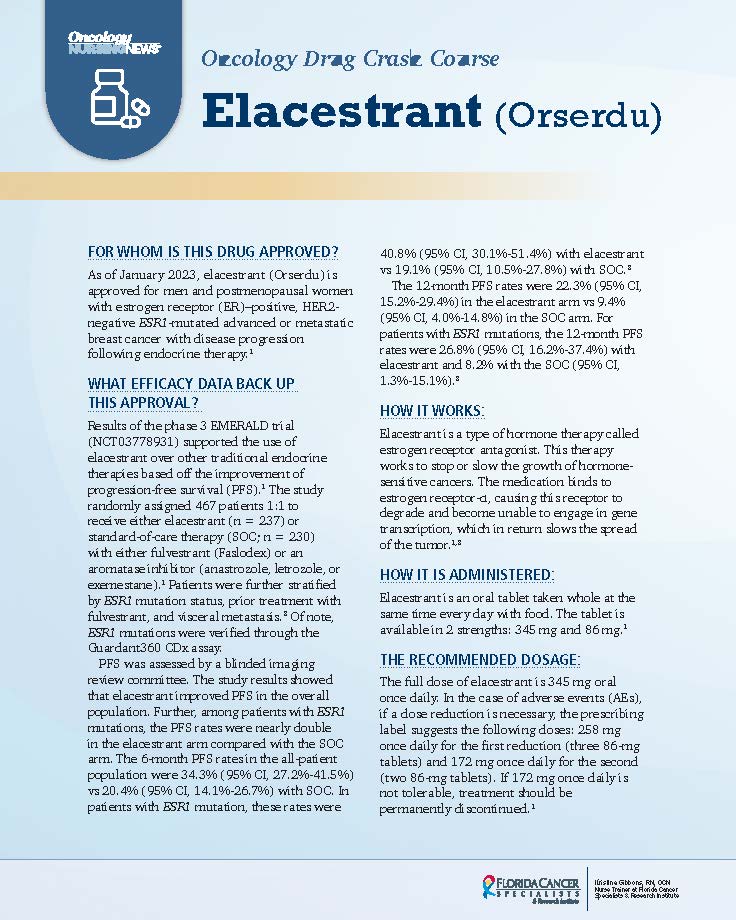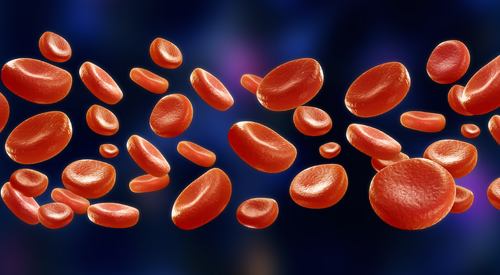Oncology Drug Crash Course: Elacestrant (Orserdu)
Kristine Gibbons, RN, OCN, who is a Nurse Trainer at Florida Cancer Specialists & Research Institute, provides an in-depth look at elacestrant in a downloadable fact sheet.
For a downloadable version that you can print at home, check out our oncology drug crash course page.
FOR WHOM IS THIS DRUG APPROVED?
As of January 2023, elacestrant (Orserdu) is approved for men and postmenopausal women with estrogen receptor (ER)–positive, HER2- negative ESR1-mutated advanced or metastatic breast cancer with disease progression following endocrine therapy.1
WHAT EFFICACY DATA BACK UP THIS APPROVAL?
Results of the phase 3 EMERALD trial (NCT03778931) supported the use of elacestrant over other traditional endocrine therapies based off the improvement of progression-free survival (PFS).1 The study randomly assigned 467 patients 1:1 to receive either elacestrant (n = 237) or standard-of-care therapy (SOC; n = 230) with either fulvestrant (Faslodex) or an aromatase inhibitor (anastrozole, letrozole, or exemestane).1 Patients were further stratified by ESR1 mutation status, prior treatment with fulvestrant, and visceral metastasis.2 Of note, ESR1 mutations were verified through the Guardant360 CDx assay.
PFS was assessed by a blinded imaging review committee. The study results showed that elacestrant improved PFS in the overall population. Further, among patients with ESR1 mutations, the PFS rates were nearly double in the elacestrant arm compared with the SOC arm. The 6-month PFS rates in the all-patient population were 34.3% (95% CI, 27.2%-41.5%) vs 20.4% (95% CI, 14.1%-26.7%) with SOC. In patients with ESR1 mutation, these rates were 40.8% (95% CI, 30.1%-51.4%) with elacestrant vs 19.1% (95% CI, 10.5%-27.8%) with SOC.2
The 12-month PFS rates were 22.3% (95% CI, 15.2%-29.4%) in the elacestrant arm vs 9.4% (95% CI, 4.0%-14.8%) in the SOC arm. For patients with ESR1 mutations, the 12-month PFS rates were 26.8% (95% CI, 16.2%-37.4%) with elacestrant and 8.2% with the SOC (95% CI, 1.3%-15.1%).2
HOW IT WORKS
Elacestrant is a type of hormone therapy called estrogen receptor antagonist. This therapy works to stop or slow the growth of hormone-sensitive cancers. The medication binds to estrogen receptor-α, causing this receptor to degrade and become unable to engage in gene transcription, which in return slows the spread of the tumor.1,2
HOW IT IS ADMINISTERED
Elacestrant is an oral tablet taken whole at the same time every day with food. The tablet is available in 2 strengths: 345 mg and 86 mg.1
THE RECOMMENDED DOSAGE
The full dose of elacestrant is 345 mg oral once daily. In the case of adverse events (AEs), if a dose reduction is necessary, the prescribing label suggests the following doses: 258 mg once daily for the first reduction (three 86-mg tablets) and 172 mg once daily for the second (two 86-mg tablets). If 172 mg once daily is not tolerable, treatment should be permanently discontinued.1
HOW TO MANAGE ASSOCIATED ADVERSE EVENTS
Patients should be instructed to call their provider if they experience any change in physical symptoms. Patients and their family should have the contact information for their health care team. Throughout treatment, patients should receive laboratory testing, including a complete blood count and basic metabolic panel.
Common physical adverse reactions associated with treatment include musculoskeletal pain, nausea, vomiting, fatigue, decreased appetite, diarrhea, constipation, headaches, and abdominal pain. In addition, about 30% of patients have some amount of dyslipidemia. This appears as hypercholesterolemia and hypertriglyceridemia.
Monitoring lipid profiles prior to and during treatment is recommended.1 Other recommended laboratory testing includes creatinine, aspartate aminotransferase (AST) and alanine transaminase (ALT); and monitoring for decreases in hemoglobin and sodium.1 The most common AE that led to a dose reduction during the trial was nausea (1.7%). The most common AEs that led to a dose interruption were nausea (3.4%), musculoskeletal pain (1.7%), and increased ALT (1.3%). The AEs that most often led to permanent discontinuation were musculoskeletal pain (1.7%) and nausea (1.3%).1
WHAT TO INFORM PATIENTS WHO ARE ABOUT TO START TREATMENT
Elacestrant is associated with fetal harm. Patients should be advised to use protection if sexually active during treatment and to continue to use protection for 1 week following the final dose.1
In addition, patients receiving elacestrant should avoid the concomitant use of strong or moderate CYP3A4 inducers and inhibitors. Patients should be advised to avoid grapefruit juice and to review their current list of medications with their provider, focusing on CYP3A4 inducers and inhibitors.1
ADVICE FOR NURSES WHO ADMINISTER THIS REGIMEN
Safety and monitoring parameters include obtaining a pregnancy test in female patients, complete blood count with differential, lipid profile, and a basic metabolic panel prior to starting elacestrant and periodically after. Prior to initiating therapy, the hepatic function should be evaluated. Avoid use in patients with severe hepatic impairment, and dose reduce for moderate impairment.
Nurses should assess for any gastrointestinal toxicity; the most reported AE is nausea. Nurses should verify that their patient has nausea medication at home and recommend taking elacestrant with food, one hour after taking nausea medication.
HOW TO SAFELY HANDLE THIS DRUG
The drug should be stored in its original container at room temperature 68 °F to 77 °F (20 °C to 25 °C).1
REFERENCES
1. Elacestrant. Prescribing information. Stemline Therapeutics, Inc; 2023. Accessed May 28, 2023. https://www.accessdata.fda.gov/drugsatfda_docs/label/2023/217639s000lbl.pdf
2. Bidard FC, Kaklamani VG, Neven P, et al. Elacestrant (oral selective estrogen receptor degrader) versus standard endocrine therapy for estrogen receptor-positive, human epidermal growth factor receptor 2-negative advanced breast cancer: results from the randomized phase III EMERALD trial. J Clin Oncol. 2022;40(28):3246-3256. doi:10.1200/JCO.22.00338
Nurse Practitioners Weigh in on Data From the San Antonio Breast Cancer Symposium
January 16th 2023Loyda Braithwaite, MSN, RN, AGPCNP-BC, AOCNP; and Jamie Carroll, APRN, CNP, MSN, highlight presentations from the 2022 San Antonio Breast Cancer Symposium that will influence oncology nursing practice.
Olaparib Plus Chemo May Not Improve Outcomes vs Chemo Alone in BRCA Wild-Type TNBC
April 23rd 2024Patients with BRCA wild-type triple-negative breast cancer treated with olaparib on a gap schedule with chemotherapy did not experience improved responses compared with chemotherapy alone in the neoadjuvant setting.





